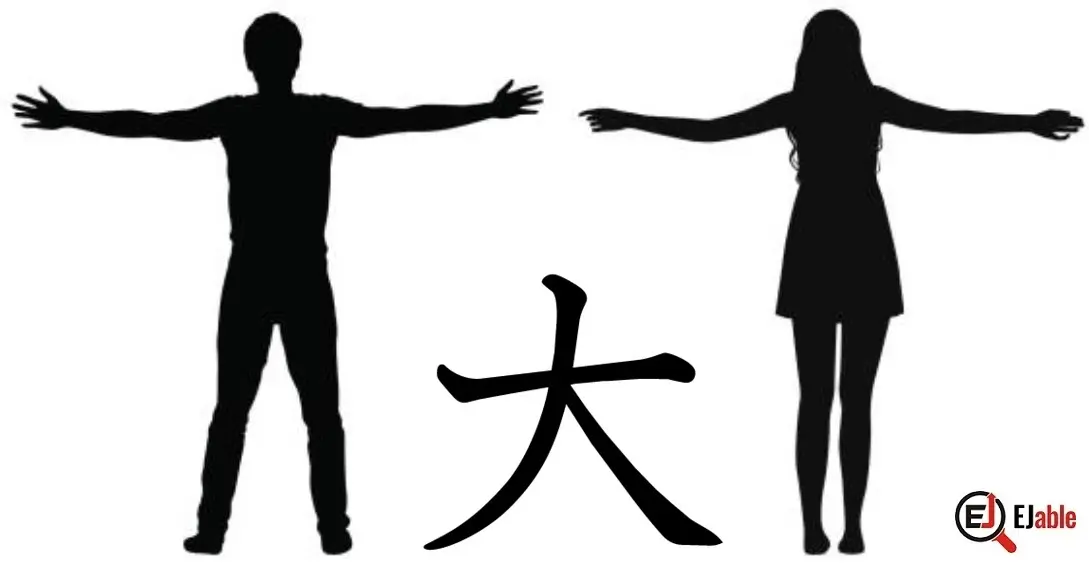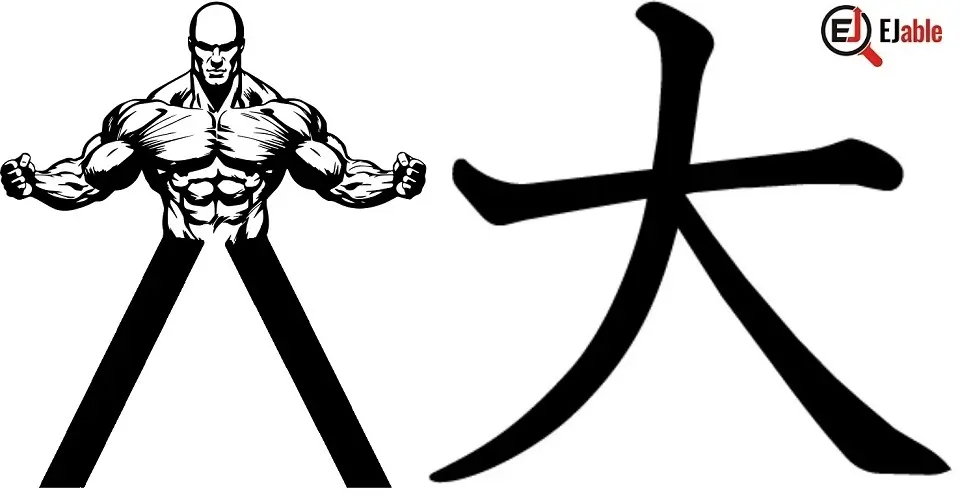Kanji for Big or Large (大, ō, Dai, or Tai)

The Japanese kanji for “big” or “large” is 大.
The Kanji 大 is constructed with 3 strokes. It is part of the JLPT N5 syllabus (please check the JLPT N5 Kanji list). In Japanese schools, this Kanji is taught in grade 1.
This article will discuss the origin of the Kanji for “Big” and easy ways to remember it. We will also discuss the radicals of this Kanji and the compounded words in which 大 appears.
Pronunciation of 大
The Japanese pronunciation of 大 is ō (as in ō-kii). However, the pronunciation becomes “tai” or “dai” when it appears in Kanji of compounded words. Please note that tai (タイ) dai (ダイ) are “onyomi, or Chinese pronunciation.
Other Meanings of 大
Apart from the primary meaning of “big” or “large,” 大 can also be used in contexts that mean:
- Great (as in significance)
- Major or main (for example, in the word “mainland” or “main street”)
- Adult (in the context of age, as in 大人 “otona” which means “adult”)
- University (when used in certain compounds, such as 大学 “daigaku” which means “university”)
The versatility of the Kanji for big allows its use in various contexts in the Japanese language, often denoting something of greater size, importance, or maturity.
Origin of the Kanji for Big (大)
Historically rooted in the ancient Chinese oracle bone script, the Kanji 大 was originally a pictographic representation of a person with arms outstretched. The stretched arms indicate “great” or “large” in size or extent. The shape itself conveys a sense of expansiveness.
The human figure, universally relatable, made the character’s message clear: something exceeding the ordinary in size or importance.
Mnemonic: How to Remember the Kanji for Large or Big (大)
If you remember the Kanji 人 for “person” or “human being,” it’s very easy to remember it for large or big by imagining the person 人 with outstretched hands gesture something large. This simple logic creates the shape 大.
However, the following illustration will serve as a mnemonic to remember the Kanji 大 quickly and unforgettably:

Cultural Significance of Kanji 大
The kanji 大 holds a special place in cultural expressions. Consider festivals like 大祭 (oo-matsuri), which translates to “grand festival.” Similarly, the term 大和 (Yamato), an ancient name for Japan, exudes a sense of pride and national identity. It’s not just a character; it’s a symbol that encompasses the ethos of greatness and reverence in various facets of Japanese culture.
大 as a Radical and Component in Other Kanji Characters
The Kanji 大 is also used as a Kanji radical and component. When it functions as a radical, it’s often called the “big radical” or “大 radical.”
Kanji 大 appears as a radical or component in 2,000 Kanji characters, including 274 Jōyō Kanji.
Examples of 大 as a radical
Following are some examples of kanji where 大 (big or large) appears as a radical:
- 天 (ten): Sky, heavens, weather, nature, top, Uranus
- 太 (ta): Thick, large, great
- 央 (ou): Center, middle
- 失 (shitsu): To lose; mistake
- 夫 (fu, bu): Husband, male worker, man
- 奥 (oku): Deep part, interior, wife
- 奮 (fun): To rouse, energetically
- 奇 (ki): Extraordinary, odd number
- 奪 (datsu): To seize
- 奉 (hou, bu): To offer, dedicate, revere nominally
- 奔 (hon): Rush
- 奈: A phonetic component (usually pronounced as “na” or “nai”) and occasionally represents the sound ナ in names and such.
This list highlights the versatility of the “big” radical in forming various kanji characters with different meanings and readings.
Compounded Kanji Using 大
The Kanji 大 representing “Big” appears frequently in compounded words relating to largeness or greatness. There are 1437 Japanese words that begin with the Kanji 大, and it appears in 1924 words.
Examples of Kanji 大 in Compounded Kanji Characters
Following are the examples where Kanji for big or large appears in Japanese compounded Kanji characters:
- 大人 (otona): Adult
- 大学 (daigaku): University
- 大事 (daiji): Important, valuable, serious matter
- 大好き (daisuki): Very likable, loveable, favorite
- 大小 (daishou): Size, dimension, large and small
- 大会 (taikai): Convention, tournament, mass meeting
- 大地 (daichi): Earth, ground, the great land
- 大気 (taiki): Atmosphere
- 大変 (taihen): Very much, greatly, immense, serious, tough
- 大声 (ōsei): Loud voice
- 大阪 (ōsaka): Osaka (a major city in Japan)
- 大家 (ōya): Landlord or landlady
- 大使 (Taishi): Ambassador
- 大統領 (daitouryou): President (of a country)
- 大雨 (ōame): Heavy rain
The above examples illustrate how the Kanji of “big,” “large,” or “great” (大) is combined with other Kanji characters to create meanings in various contexts related to the concept of big or large.
Check other Kanji characters on the page “How to Remember Kanji“.

A long-term ex-pat in Japan, Himanshu comes with an IT background in SAP consulting, IT Business Development, and then running the country operations of an IT consulting multinational. Himanshu is the co-founder and Managing Director of ReachExt K.K. and EJable.com. He is also an Advisory Board Member of a Silicon Valley AI/IoT startup.
